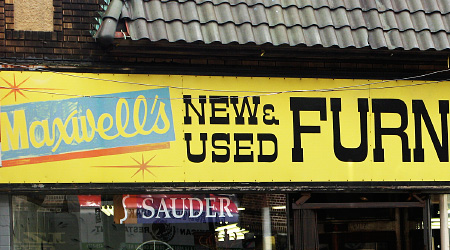How to Buy Used Furniture

With so many ways to buy used furniture available at the click of a mouse, it's tempting to ditch traditional retail stores altogether and go second-hand for all your furniture needs. Buyer beware, however; there are important tips you need to know when going the way of "previously-owned."
There are SO many places to buy used these days: Craigslist, your local Re-Store, the Salvation Army, Goodwill, a garage sale, the newspaper classifieds, and even an old college roommate. But how can you sort the good from the bad? We've got just the right tips to get you started.
Furniture You Shouldn't Buy Used
Some furniture was never built for more than one owner, and worse yet, won't survive any kind of move (even the move from their original home to yours.) Items that most likely won't be a long-term investment include:
- Pine lumber sofas or living room furniture - Without a solid hardwood frame-- like maple or oak--it generally won't live through a move and a second owner.
- Sofas with mesh support or worse yet, peanuts for cushions - These won't withstand the test of time. Instead, look for eight-way hand tied construction and cushions with down and wrapped foam.
- Chairs that have stapled joints - Check underneath the seat for corner blocking that is not only glued, but also bolted for true support. It's going to carry the weight of your friends and family, and you don't want to see them on the floor!
- Second hand lamps that short out when you plug them in for testing - Unless you are prepared to re-wire them or take them to be re-wired, they are a potential electrical and fire hazard in your home.
- Used cribs - In addition to the fact that many of them are already recalled (you can check the CPSC.gov website for all the models of recalled cribs), if you don't know the previous owner, there may be wear and tear defects, as well as weakening or loosening of joint construction that could cause harm to your baby. It's best to be safe and not skimp here!
- Second-hand mattresses - Even if it's spotless and appears to be unused with the tags still attached, you never know what lies beneath.
Quick and Dirty Tips for Buying Second-Hand Furniture
Not sure you're ready to take the plunge on used furniture? Here is our list of quick and dirty tips for buying used furniture:
- Draw the line between "character" and "damaged goods." Water rings, discoloration in wood, and minor dings are all fixable and contribute to character. Water damage, wood worm, and split timber are characteristics of decay.
- Don't let the price tags sway you. Just because that nine-foot leather sofa is $300.00, doesn't mean you must have it. Cost shouldn't be the sole reason for purchase. Consider the size, color, and lines just as you would with any new furniture purchase. Otherwise, you'll have a 300.00 albatross and still no sofa.
- Don't turn up your nose at a piece just because of the color or fabric. When considering upholstered goods, take an analytical look at the line and scale. In the right material, you could have a gem for generations. You'll also want to have anything upholstered that you buy second hand recovered and refilled with new materials for environmental health reasons. A piece may look clean, but there could be any number of things going on underneath, from pet dander to molds.
- Pay attention to smell. If a piece smells funny, but has somehow charmed you, consider how you will cope with the stink. It can't stay in the garage forever. For upholstery, get it recovered and get new filling. Baking soda will do you no good. For wooden pieces, such as chests, leave drawers in the sun for an afternoon. That will open the woods pores and release odors. When indoors, try baking soda to absorb excess odors.
- Be realistic about repairs: If a piece is being sold as damaged, say a dining table, don't be over ambitious with repairs needed. Something may look like a simple fix (putting the gloss back on the table top), but could end up making a problem worse (ending up with a sticky mess from too many different products). Be realistic with your range of abilities.
- Try out the furniture. When purchasing second hand, whether from a resale shop, antique store, or estate sale, try the furniture out. Open the drawers; sit on the chair; lean on the table. Everyday activities and mundane actions will often reveal hidden structural issues you wouldn't see if you only looked at the pieces. If it feels solid, it usually is.
Re-purpose Used Furniture with Care
One last tip about buying used furniture. Nothing's more chic than finding a unique antique furniture piece that looks beautiful AND offers oodles of storage. Though it is perfectly acceptable to use old pieces for something other than their original purpose, be aware that some items are not designed for certain uses. For example, avoid using an antique china hutch or similar piece for audio/video equipment. These types of pieces don't have adequate ventilation for electronics that require fans or that generate heat, and so your electronics could overheat,a damaging the wood finish, and possibly even causing fire. You should also avoid putting a beautiful non-treated wood piece in an area that will experience water exposure. If you decide to take an antique dresser and re-purpose it as a bathroom sink foundation, for example, be sure to refinish it with a waterproof finish.







